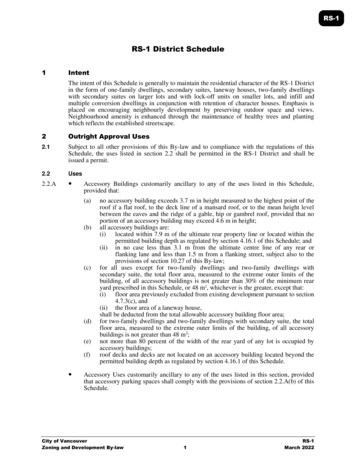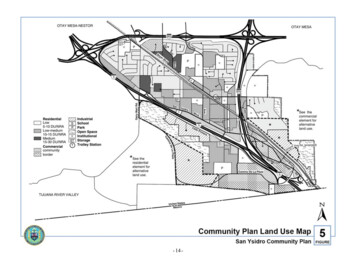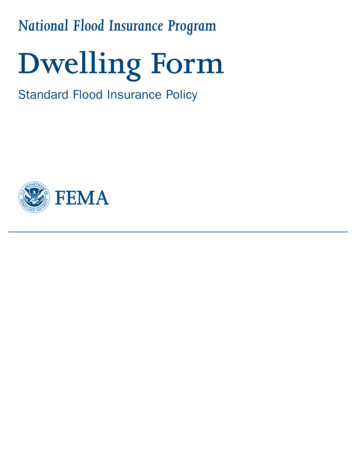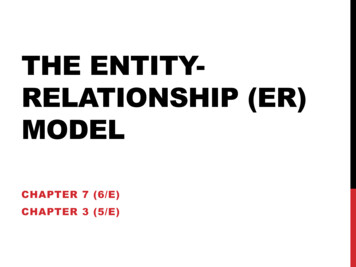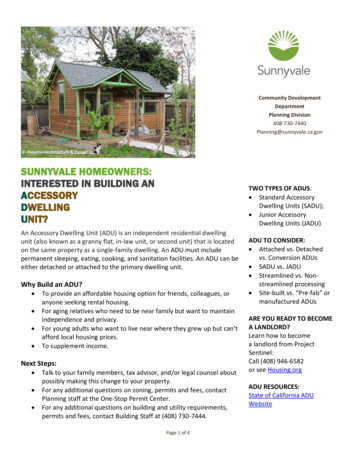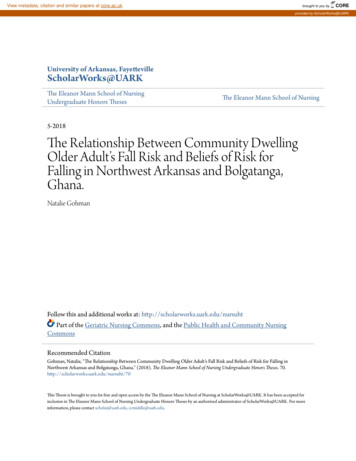
Transcription
View metadata, citation and similar papers at core.ac.ukbrought to you byCOREprovided by ScholarWorks@UARKUniversity of Arkansas, FayettevilleScholarWorks@UARKThe Eleanor Mann School of NursingUndergraduate Honors ThesesThe Eleanor Mann School of Nursing5-2018The Relationship Between Community DwellingOlder Adult’s Fall Risk and Beliefs of Risk forFalling in Northwest Arkansas and Bolgatanga,Ghana.Natalie GohmanFollow this and additional works at: http://scholarworks.uark.edu/nursuhtPart of the Geriatric Nursing Commons, and the Public Health and Community NursingCommonsRecommended CitationGohman, Natalie, "The Relationship Between Community Dwelling Older Adult’s Fall Risk and Beliefs of Risk for Falling inNorthwest Arkansas and Bolgatanga, Ghana." (2018). The Eleanor Mann School of Nursing Undergraduate Honors Theses. 70.http://scholarworks.uark.edu/nursuht/70This Thesis is brought to you for free and open access by the The Eleanor Mann School of Nursing at ScholarWorks@UARK. It has been accepted forinclusion in The Eleanor Mann School of Nursing Undergraduate Honors Theses by an authorized administrator of ScholarWorks@UARK. For moreinformation, please contact scholar@uark.edu, ccmiddle@uark.edu.
Fall Risks in Older AdultsThe Relationship Between Community Dwelling Older Adult’s Fall Riskand Beliefs of Risk for Falling in Northwest Arkansas and Bolgatanga, GhanaAn honors thesis/project in partial fulfillmentof the requirements for the degree ofHonors Baccalaureate in NursingBy: Natalie GohmanHonors Nursing StudentFebruary 19, 2018This honors undergraduate thesis/project is approved for recommendation to the College ofEducation and Health Professions Honors Council.Dr. Susan PattonThesis MentorDr. Nan Smith-BlairCommittee MemberCarol AganaCommittee Member
Fall Risks in Older AdultsIntroductionOlder adults worldwide live with physical and psychological changes associatedwith aging along with comorbidities. Though the presence of such conditions can be lifethreatening, research has found older adults are more likely to die as a result of falling.As the worldwide population of individuals over 65 rises, so will the possibility forinjuries from falls. Much research has been published concerning fall risk protocols indeveloping countries, but minimal research surrounding protocols and practices forprotecting against falls in underdeveloped countries has been published. An agingpopulation raises concern of how to better prepare those in the community to preventcomplications of falling. The purpose of this study is to evaluate the relationshipbetween an individual’s fall risk and the perceived belief of their risk for falling.Older adults at the Senior Center in Fayetteville, Arkansas and villages inBolgatanga, Ghana where assessed using the Stopping Elderly Accidents, Deaths &Injuries (STEADI) fall risk assessment tool created by the Center for DiseasesControl and Prevention. The assessment was followed by a questionnaire focused onattitudes, beliefs, and barriers pertaining to their fall risk. The relationship betweenthe actual fall risks to the individual’s perceived risk was examined. Understandinga person’s beliefs of fall susceptibility, fall severity, and barriers and facilitators tofall prevention can help health professionals tailor preventative and teachingstrategies to reduce falls.Relationship Between Older Adults Fall Risk and Beliefs for Risk of FallingThe fear of falling is a burden that many older adults face every day. Falls are theleading cause of death and the third leading cause of complications associated with2
Fall Risks in Older Adultschronic illnesses in adults over the age of 65 in the United States (Rosen, Macka, &Noonan, 2013; Scheffer, Schuurmans, Van Diik, Van, & De Rooij, 2008). There areapproximately 20,000 deaths in older adults reported each year related to falls(Stevens & Phelan, 2013). The estimated population over 65 years of age was 43.1million in 2012 in the US; this number is expected to almost double by 2050 to aprojected 83.7 million (Ortman, Velkoff, & Hogan, 2014). Many older adultsunderstand risk factors and preventive measures associated with falls, but minimizetheir susceptibility (Hughes et al., 2008). Fall related injuries lead to poor healthoutcomes in older adults, as well as increased health care consumption and cost,decreased mobility, loss of independence, and consequential long-term reduced qualityof life (Hartholt et al., 2011; Stevens & Phelan, 2013). The purpose of this study is toassess the relationship between older adults’ fall risks, and the beliefs about their riskfor falling. Interventions can then be identified that will help to reduce reported falls inthe future.Review of LiteratureCDC STEADI Tool Kit and the Health Belief ModelFall risk assessments are conducted to identify risk factors that make anindividual more susceptible to experience a fall. Evidence-based protocols includeassessing intrinsic and extrinsic risk factors to prevent falls from occurring in thecommunity (National Guidance Clearinghouse, 2012). If a patient is identified as arisk for falling in the acute setting, education of the patient and family caregivers isrequired to promote prevention of further falls once discharged (NGC, 2012). Inrecent years, healthcare facilities have increased their use of evidence-based fall risk3
Fall Risks in Older Adultsassessments, but fall risk assessment of community-dwelling older adults has beenlimited (Goodwin, Jones-Hughes, Thompson-Coon, Boddy, & Stein, 2011).Stopping elderly accidents, deaths, and injuries (STEADI) is a fall risk assessment toolkit created by the Centers for Disease Control and Prevention’s Injury Center (CDC) to providehealth care professionals with resources to assess and address patient’s fall risks (Stevens &Phelan, 2013). CDC researchers created STEADI after an analysis of the literature identified thatcommunity physicians could not adequately recognize fall and gait disorders or evaluate patientswho reported recent falls (CDC, 2015). STEADI was created to identify modifiable risk factorsusing an evidence- based design based on Wagner’s Chronic Care Model (Stevens & Phelan,2013). A study conducted in 2011 at the Oregon Health and Science University evaluatedimplementation of the STEADI fall risk assessment into clinical practice. STEADI wasintegrated into the normal clinical flow using EPIC electronic health record, and a onehourtraining session was conducted to teach users the seriousness of falls and how to usethe program (Casey, Parker, Winkler, Lambert, & Eckstrom, 2016). Results indicateSTEADI tools were easily implemented and effective. The vision of the CDC to create aclinical setting that proactively identified and addressed fall risk in older adults was thedriving force of the study (Casey, Parker, Winkler, Lambert, & Eckstrom, 2016). ThisSTEADI initiative combined community-based referrals and clinic, provider, and patientbased components to identify and address fall risk. Authors also conclude that support isrequired to sustain the fall risk screening into clinical practice.The Health Belief Model is a tool used to explain and predict a variety ofhealth related behaviors (Glanz, Rimer, & Lewis, 2002) and has been used in thedesign of this study. The constructs of the model include perceived benefits andrisks to action, risk susceptibility and severity, self-efficacy, and cues to action4
Fall Risks in Older Adults(Jones et al., 2015). These perceptions are combined to influence health behaviorssuch as fall prevention. (Jones et al., 2015).A person’s perceived susceptibility focuses on their belief for the risk ofcontracting a certain illness or condition (Stretcher & Rosenstock, 1997). The perceivedseverity is the degree to which someone is threatened by the illness. An individual’scourse of action depends on how effective they believe the benefits will be to reduce thethreat, while perceived barriers are the negative aspects of agreeing to the recommendedbehavior (Sterthcer & Rosenstock, 1997). Cues that trigger certain behaviors are alsodiscussed. Self- efficacy is defined as an individual perception that a change in behaviorwill lead to the desired outcome (Stretcher & Rosenstock, 1997). All of these constructswere used to guide interventions for this study.Factors for FallingFalls are often associated with underlying biological and psychological riskfactors that have increased that individual’s likelihood to fall. Biological factors includemuscle weakness, impaired gait, slower reflexes, and foot problems (CDC, 2015;National Institute on Aging, 2017). Psychological factors include sensory deficits,confusion, and medication adverse effects (National Institute on Aging, 2017).Individuals that experience chronic illnesses, along with functional impairments, are atincreased risk for falls (Nicklett, Taylor, 2014).The CDC and Control and the U.S. Consumer Product Safety Commissionutilized data from the 2001–2008 National Electronic Injury Surveillance System-AllInjury Program (NEISS-AIP) to find that annually 37,991 emergency department visitsare the result of falls due to throw rugs and carpets in the home environment (Rosen,5
Fall Risks in Older AdultsMacka, Noonan, 2013). Hazards that are assessed in the home are commonlycategorized per room. Hazards include but are not limited to lack of railings, lightingand grab bars, uneven steps, lack of lighting, unstable flooring, throw rugs, electricalcords, high cabinets, slippery floors, pets, and height of the bed and toilet (HSSAT).Demographics of FallingResearch on falls in African countries is sparse. Apart from South Africa, no Africancountries provide information for managing and preventing falls in the elderly (Kalula, 2011). Astudy conducted on 105 subjects in three suburbs of South Africa found that increasedfalls were strongly linked to environmental factors (Kalula, Ferreira, Swingler, Badri,2016). Poorly maintained external environments, small-overcrowded dwellings, poorlymaintained public buildings, and nonexistent street lighting contributed to causing falls(Kalula, Ferreira, Swingler, Badri, 2016).There is very little data describing fall rates in many regions of the world. There isno real “epidemiological data available for Africa, South Asia and the WHO EasternMediterranean region” (Yoshida, 2009). The CDC generates data every year discussingthe number of falls for older adults for the United States, and there is yearly data for otherdeveloped countries surrounding the populations past yearly falls. The proportion of fallsvaries depending on the country and target population being studied, and manypopulations in the world do not have any data concerning their fall risk.Though there is not data for all countries in regards to falling, there is a clearracial difference in fatal fall rates. Falls “increase with age for both genders and amongdifferent races,” and it was found that “white men have highest fatal fall rates followedby white women, black men, and black women. (Yoshida, 2009). The Health andRetirement Study is a population-based study that analyzes older adults progress through6
Fall Risks in Older Adultsthe 1990s and early 2000s (Nicklett, Taylor, 2014). A study based on data collected from2000-2010 HRS found that African Americans are less likely to experience recurrent fallsin comparison to non-Hispanic whites (Nicklett, Taylor, 2014).Regardless of country of origin, gender, or race, falls in the older adult populationare increasing each year, and will continue to rise with the global increase in thepopulation of adults over the age of 65 in the coming years.Stigma surrounding FallingMany older adults are unaware of the term ‘falls prevention’ and are thereforeunaware of the falls prevention interventions that can be life saving (Bunn,Dickinson, Barnett-Page, McInnes, & Horton, 2008). Negative perceptions, includingsocial embarrassment, indignity, and damage to confidence, cause many over 65 torefute the idea that they are susceptible to falls and therefore do not need to work toprevent their occurrence (Hughes et al., 2008).Members of sheltered accommodation communities stated falls preventioninformation was common sense, and not applicable to their everyday lives (Hughes etal., 2008). Another study conducted in 2001 on an older adult population in Sydney,Australia found a barrier to making home modifications to prevent falls is thatindividuals do not believe they will reduce their risk (Cumming et al., 2001).The fear of falling is prevalent in older adults, yet many do not adhere tosafety measures because they deny the need for implementation (Cumming, et al,.2001; Hughes, et al., 2008; Yardely, Donovan-Hall, Francis, & Todd, 2006). Whenconfronted about the need to adhere to safety measures, some felt stigmatized thatthey were being asked to use a cane, walker, and grab-bars (Bunn, et al., 2008;7
Fall Risks in Older AdultsCumming, et al., 2001). Many older adults do not perceive a correlation betweentheir fall risk and falling (Hartholt, et al., 2011; Hughes, et al., 2008; Bunn,Dickinson, Barnett-Page, McInnes, Horton, 2008).Because of this attitude, conducting fall risk assessments and interventionsalong with strategies for behavior change are necessary to provide the older adultpopulation with awareness of hazards within the community that make themsusceptible to falls.Research QuestionWhat are older adult’s beliefs about their risk for falling and how do they relate toassessed fall risk?MethodsThis study was conducted following approval by the Institutional Review Boardof the University of Arkansas. Written informed consent was obtained from eachparticipant.Research DesignA mixed method approach was used to examine older adult’s health beliefsabout fall risk. Semi-structured interviews based on constructs of the Health BeliefModel were used to collect data. Risk factors for falls were determined using theCenter for Disease Control STEADI fall risk assessment tool.InstrumentsThe STEADI fall risk assessment tool c1onsists of screening questions, astrength and gait assessments, vision test, and measurement of vital signs. Questions8
Fall Risks in Older Adultsare asked to determine: falls history, medical conditions that may increase risk offalling, and medications.The Timed Up and Go (TUG) Test was used to assess functional ability. TheTUG test measures the older adult’s ability to stand up from a chair with an arm rest,walk 10 feet or 3 meters at normal pace, turn, and walk back at normal pace and sit down.According to the STEADI guidelines, an older adult who takes 12 seconds to completethe TUG is at risk for falling.The 30 second chair stand was used to test leg strength and endurance. The olderadult was asked to sit in the middle of the chair with arms against chest and rise to a fullstanding position and then sit back down. This was repeated for 30 seconds. According toSTEADI guidelines, the below average cut scores for adults in the age group 70-74 is 12for men and 10 for women.For this study, an additional portion to measure strength was added. Eachparticipant did a 5-time sit to stand test. This consisted of assessing how long it tookthe participant to stand up and sit down 5 times. This time was then recorded inseconds. The 5-time sit to stand test was compared to the 30-Second Chair StandTest.Balance was last assessed by asking the participants to stand in four differentpositions. First the participant would stand normally with feet slightly apart. For thesecond position one foot was moved slightly in front of the other, and the thirdposition was one foot all the way in front of the other. The last position theparticipant was asked to do was stand on one foot. Each position was required to beheld for 10 seconds. If the participant was not able to hold all four positions for 109
Fall Risks in Older Adultsseconds then they did not pass this portion of the test.Vision was tested using a Tumbling ”E” Eye Chart. The eye chart was held14” from the participants face to simulate the correct distance to measure eye acuity.The participant was then asked to point in the direction that the lines of the “E” werefacing. If it was determined that the participant had not had an eye exam in the pastyear, then visual acuity was identified as a factor in falling.Postural hypotension was measured while the patient was sitting and thenstanding. The two blood pressures were compared to determine if orthostatichypotension could be a factor that would increase risk for falling.The semi-structured interviews were recorded and consisted of questionsfrom the 6 constructs of the health belief model: severity, susceptibility, selfefficacy, benefit, barriers, and cue to action.SampleThe relationship between self-perceived risk of falls and risk factors for fallswas examined using a purposive, convenience sample of older adults in NorthwestArkansas and Ghana, Africa. In total, 35 participants were included in the sampleand participated in the study from June 2017-August 2017. The sample selectionwas limited to adults over the age of 55. Participants included from NorthwestArkansas were members of the Fayetteville Senior Center. The participants utilizedfrom Bolgatanga, Ghana were members of the local Zaare village.Data collection techniques include individual interviews, field notes, andfindings from the falls risk assessment. Demographical data consisting of age, sex,and ethnicity were recorded.10
Fall Risks in Older AdultsDescriptive statistics were used to obtain simple frequencies and calculate thepercentage of older adults within different subgroups.The one way ANOVA was used for analysis of continuous variables, using IBMSPSS24.ResultsTable 1. Descriptive Statistics and Comparison of MeansN%TUG TestP value ( 95% CI)meanscore (SD)All older adults35 100 19.14 (9.577)Mean Age 72GenderFemale25 71.4 18.20MaleCountryGhanaMean age 69NWAMean age 75History of FallingFell past year8Did not fall232491022.915.1372.718.83 (4.1)25.713.78(2.05)28.616.765.719.2.078 (-6.5 - .36)300 chairstandmean (SD)9.97 (3.07)10.08(3.13)9.97 (3.18)P value ( 95%CI).874 (-2.81-2.40)9.76 (3.11).001 (-8 - -2.1.125 (-5.75-.74)10.55(3.04)10.22(3.41)9.6 (2.32).513 (-1.66 – 3.25).617 (-1.80 -3.03)The box plot diagram was created and used to identify outliers and discard themfrom the data series before making further observation. Cases 1 and 29 were excludedfrom the observations. See Table 1. For descriptive statistics and comparisons of means.The only significant difference in results of the STEADI tests between the residents ofNWA and Ghana was in the timed up and go.11
Fall Risks in Older AdultsFigure 1. Box Plots of TUG resultsQualitative ResultsAnalysis of the semi-structured interviews (N 20) revealed four main themes:participants didn’t feel that they would fall, falling is not good, prevention of falls is hard,and falling is out of our control. The following table summarizes and compares responsesmade by participants from NWA and Ghana.ThemeI won’t fallNWAI suppose, I just don’t intend to fall if I can keepfrom it (Case 30). I see I’m coming up tosomething I’m going to look down. I don’t wantto fall over cracks in the ground or on thehighway. I’m going to look down (Case 27). Iwould say 1 out of 100 I will fall. Most timeswhen I’m walking I’m careful already so Iwould say one out of 100 (Case 27).Falling isnot goodShe says her kids and others around her wouldbe worried because when she falls and getinjured they would have to take her to the12GhanaShe hasn’t tried anything that would prevent her fromfalling (Case 1).Very confident because she is a strong woman (Case 4).She says she is very confident that she wouldn’t fallalthough sometimes she says she tries to gets up and thenshe gets some sort of dizziness sometimes so when thathappens she tries to maintain her position, other than thatshe is very sure she wouldn’t fall (Case 5).She thinks her chance of falling is very low (Case 1).The people around her would worry when she falls down(Case 4). If kids around they will have burden to take careof her then. Because of old age if she falls she could have
Fall Risks in Older Adultshospital (Case 25). Probably would be adisaster, it would be harder on others (Case 34).Well at this age with osteopenia andosteoporosis I would break something (Case28).Preventingfalling ishardIf it’s in the evening I don’t keep enough lightson or something like that, and not payingattention, or getting in a crowd (Case 34).Falling isout of mycontrolNot noticing something down low, or somethingsticking out, your knees are below otherwiseyou are generally watching (Case 30). Walkingin fields where I don’t know if there are holesaround (Case 28).a broken bone. (Case 6). Benefits she talks of is when sheclears the path the risk of injury is very low and the risk offalling is low so she doesn’t really get injured becausethere’s no stuff there that would injure her, and that bringssafety to her children that play around and they would notget injured due to the obstacles in the way (Case 25).The barriers are the local building and how it is. If we gothis way you see how they build a short wall those barriersare what she finds difficult in getting across she takescaution (Case 5). Barriers are is maybe the bicycle that heuses sometimes so he tries to be careful bc that could alsomess him up (Case 7).His knee and the feet that he complains a lot that he can’twalk and sometimes he loses his balance (Case 7). Shesays that her feet hurt a lot and that might make her fall(Case 9). Maybe when you walk and obstacles or whenthe floor is slippery, she can slip then fall down (Case 4).Table 1. Summary of responses concerning participants perceived fall risk in NWA andGhana1. I Won’t FallThe majority of the participants interviewed stated that they did not think they had arisk of falling. Of the total 35 participants 13 reported that they have fallen in the pastyear. Participants were asked if they had tried things to prevent falling in the past andhow confident they were that they wouldn’t fall.1.1 Ideas to Prevent FallsIn both Ghana and Northwest, Arkansas, there was a lack of knowledge by thegeneral population of what to do to prevent falling and if anything has been tried in thepast or present to prevent falling. When asked about falling people, older adults fell intotwo categories based on their answers, those that have tried strategies and those thathadn’t. Over half of the participants stated “I haven’t really tried anything” (Case 7). Afew participants stated that you could “clear your path” (Case 5) and be cautious whenwalking around by “looking down at the ground” (Case 27).I’ve taken balance classes. I haven’t taken any in a long time, but I used to take a lot13
Fall Risks in Older Adultsof classes that helped me (Case 34).1.2 Confidence to Prevent FallingWhen asked about the confidence level to prevent falling, there were mixedreactions ranging from laughing, being concerned, to being serious. A total of 12participants stated they feel confident they could prevent falling. In general, more wereconfident despite assessment findings showing the high fall risk. Some participantsbrushed the question off stating “Oh yea, I’m confident” (Case 33), while others showedconcern as “she is not confident that all those things could prevent her from falling”(Case 9). A few participants were confident that falling could be prevented by simplypaying attention.It’s just paying attention, that’s about as confident as you can get because ifyou’re not paying attention you will mess up. But I look very carefully. When you’repride gets involve in you activities you can mess up big time. (Case 30)2. Falling is Not GoodFalling not only affects an individual, it also affects the family and caregiversemotionally as well as physically. Stress is placed on the individual that fell, thecaregiver and patient relationship, and the caregiver’s personal emotional state.Knowing how to prevent falling will not only benefit the safety of older adults, but willease the burden so many caregivers face when helping their loved ones.2.1 Effects of Falling on the IndividualIt is common for older adults to suffer an injury secondary to the primary fall. “Shethinks what might happen if she fell is her should will have a dislocation again. She hasalready experienced this once.” (Case 5). “She says when she falls is that she is very old14
Fall Risks in Older Adultsand she is afraid that there might be some kind of fracture when she falls down.” (Case10). Older adults have a decrease in bone density due to the pathophysiological effectsof aging, placing people at an increased risk of injury due to “osteopenia andosteoporosis.” (Case 28). Two participants stated that they don’t know what couldhappen if they fell, while two others didn’t seem to recognize the possible severity that afall could have on their physical well being. Overall, 14 participants recognized thepossibility of a physical injury.“Well I don’t know what could happen it depends, the main this is not to hit yourhead.” (Case 26).“Well I would hope if I fell I would just get up pretty quick.” (Case 35)2.2 Effects of Falling on the Family and CaregiversParticipants realized the emotional effects that falling would have on the caregiver.The increase in workload on the caregiver was the main concern. Half of the participantsstated that their family “would be worried,” (Case 4) and they recognized family “willhave a burden to take care of them” (Case 6). For some living in Northwest Arkansas,they stated the possible need to “go to the hospital if needed and they would take care”(Case 26) of any injuries. For a family member with a loved one in the hospital, thiscauses increased stress.“She thinks that maybe the kids will be worried because any problem the kids areto take care of her.” (Case 5)“Her kids and others around her would be worried because when she falls andgets injured they would have to take her to the hospital.” (Case 25)Two participants brought forth a very important reality for many older adults:15
Fall Risks in Older Adultshundreds of older adults live alone due to being widowed. They stated that, because ofliving alone, falling “probably wouldn’t change anything” (Case 27).2.3 Effects of Falling on FriendsSome older adults included in this study were not only thinking of the effects thatfalling would have on their own lives, but on the lives of friends that they wereresponsible for helping.“I do help an amputee out in town. It would probably affect me being able to helpthem sometimes.” (Case 32).3. Preventing Falling is HardPreventative measures and health promotion are proven effective in decreasing thepossibility of falling, but often older adults believe they have a low fall risk. The beliefof a low fall risk along with uncontrollable environmental fall risk factors makes fallingdifficult to prevent.3.1 What are my Chances of Falling?When asked about the chances of falling only one individual admitted they were at ahigh chance of falling, stating “without my husband I would fall a lot” (Case 29). Intotal, eight participants admitted they had a low fall risk either because they had notfallen, or because they were cautious. One lady stated she had a balance test conducted acouple of years ago and it said her chance of falling was “40%, which was higher thanwhat I though it was going to be” (Case 34). Six participants out of 20 felt they wereunsure of their chances of falling, and one participant stated “well that you just don’tever know” (Case 35).“I can’t prognosis that at all because you loose your balance and a lot of things16
Fall Risks in Older Adultscould happen.” (Case 30).3.2 Prevention TechniquesClearing the path, removing rugs, stairs, and having non-slippery shoes areprevention strategies used to decrease the risk of falling. “She tries to put on shoes thatare very flat that are not slippery” (Case 5). Multiple participants reported watching for“rugs or anything like that” (Case 34) which might cause them to fall down. Oneparticipant stated that she “keeps a light in the bathroom at night .in the shower I’vegot a rubber pat so my feet don’t slip” (Case 35).Doing some “balance exercises” (Case 27) was found to helpful for one participantin increasing balance that could prevent her from falling. For those in Africa having aclear path to walk on would greatly reduce the risk of falling. “There are paths,obstacles, or maybe rocks or stones on the way and what she could do is prevent thosepaths that she goes through” (Case 4) or maybe “move the obstacles in the way” (Case7).Of the 20 participants included 7 of them stated they did not know any preventionstrategies that would keep them from falling.“She has no idea the things that could prevent her from falling.” (Case 8)“No, but I’m not to that point right now.” (Case 33)3.3 There are Barriers for PreventionThe biggest barriers discussed to prevent falling where the layout of homes andbuildings, physical outside environment, and a lack of lighting to see where one waswalking. In Africa, the biggest barrier to preventing falling was the layout of thecompound where participants lived. In the compound, the floor is “not cemented so17
Fall Risks in Older Adultsthere are potholes” (Case 8). In Ghana, leading into many of the buildings there was asmall ledge that participants had to step over to enter the room. One participant stated“those barriers are what she finds difficult in getting around, she takes caution” (Case 5).The physical environment of being outside with stones, walking in tall grass, andcracks in the ground make people more likely to fall. “Stones on the ground” (Case 6)and “weeds that on the path were water is fetched” (Case 25) were barriers created bythe physical environment in Ghana.“Somebody else trying to get your attention t
This Thesis is brought to you for free and open access by the The Eleanor Mann School of Nursing at ScholarWorks@UARK. It has been accepted for inclusion in The Eleanor Mann School of Nursing Undergraduate Honors Theses by an authorized administrator of ScholarWorks@UARK. For more information, please contactscholar@uark.edu, ccmiddle@uark.edu.


